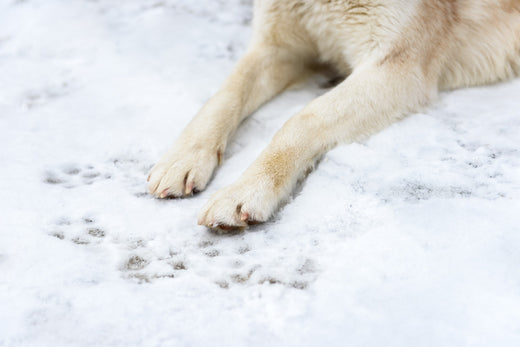 With all the fun of running and jumping around in the snow come risks that our four-legged friends carry every winter. Depending on the breed, some dogs are more susceptible to those risks than others. With that being said, owning a Siberian husky doesn’t mean that we should neglect the potential damage during the cold season can inflict on their bodies, particularly their paws. Taking care of your dog's paws is essential to their health and well-being. That is especially true during wintertime, when the snow and the ice provide many dangers. In this article, we’ll take a look at some of the things you need to know about your dog’s paws care in cold weather conditions.
With all the fun of running and jumping around in the snow come risks that our four-legged friends carry every winter. Depending on the breed, some dogs are more susceptible to those risks than others. With that being said, owning a Siberian husky doesn’t mean that we should neglect the potential damage during the cold season can inflict on their bodies, particularly their paws. Taking care of your dog's paws is essential to their health and well-being. That is especially true during wintertime, when the snow and the ice provide many dangers. In this article, we’ll take a look at some of the things you need to know about your dog’s paws care in cold weather conditions.
How Does The Cold Weather Affect Dog Paws?
Frostbite On Dogs Paws
Frostbite is a common condition that affects many animals during the cold season. It is caused by the loss of blood supply to the skin. The tissue under the skin freezes, causing inflammation and painful cracking of the skin. Frostbite frequently occurs when your dog plays in the snow for extended periods of time and his paws become wet and cold. While it’s not permanent, frostbite can be painful and could require treatment, depending on how severe it is. It can be prevented by keeping your dog in a warm environment, keeping their walks in the park short, and having them wear doggie boots.
Torn Paw Pad
Paws can get exposed to hard-to-see rocks and other sharp objects during walks in snowy conditions. Careless strolling can lead to tears and cuts of various depths, which can lead to pain, discomfort and in severe cases - infection. The easiest way to prevent pad tears is to have your pup wear doggie boots. Regular paw checks are also necessary to be constantly aware of their condition. In case you notice a tear in your pooch’s paw pad, do not hesitate to apply some antibiotic ointment and bandages and take them to the vet for further inspection.
Paw Infections
Frequent exposure to wet and cold conditions can lead to infections such as cellulitis. This is an infection of soft tissues under the skin that causes swelling and redness around the affected areas. If you suspect that your dog’s foot could be infected, it is best to limit their movement and take them to the vet as soon as possible. If you attempt to treat the infection yourself, do not apply any type of ointment or antibiotic cream at this stage, because it will delay the skin from closing. Just clean around the area with warm water and mild soap, and apply a thin layer of petroleum jelly to the wound to keep it from drying. You can apply a small amount of olive oil to the area to help it heal faster and to keep it from becoming too dry.
Hypothermia
Hypothermia is a condition during which the internal body temperature drops below the normal range of 99.5 F°. It is also referred to as low body temperature. Hypothermia is a medical emergency and should be treated as soon as possible. It occurs when a dog gets wet and is exposed to cold temperature for an extended period of time. They become unable to generate enough heat in their body and if not attended to in time, they succumb to hypothermia. The symptoms of hypothermia in dogs are shivering and lethargic behavior. When a dog is suffering from hypothermia the animal's energy resources are very low. It is important to take them to a warm place as soon as possible and wrap them in a blanket while holding them close to your body. You may also give them warm water to drink in order to raise their temperature.
Tendon injuries
The tendons between the dog’s bones and muscle tissue can often suffer injury when they walk on snow, ice or any kind of slippery surface. The initial symptoms can be swollen limbs and unwillingness to move or put weight on the affected area. Tendon injuries are not always painful, but they should always be taken seriously by owners and attended to by a veterinarian.
Extra Winter Paw Care Tips:
There are a few things that you can do to help keep your dog warm during the winter and protect him from the harmful effects of the cold weather.
Provide Plenty Of Exercise
Make sure your dog gets plenty of exercise during the winter months, so that they induce blood flow and burn calories. Physical activity will also help keep their muscles from getting stiff and sore. Inactivity during the winter can lead to overall mass loss, which makes it harder for them to regulate their body temperature. Additionally, it will also help them stay hydrated and maintain an appetite for nutritious foods.
Provide Your Dog With Plenty Of Food and Water
In winter, dogs need extra energy to keep them warm. They also need extra nutrients to help them strengthen their bones and muscles. You should feed your dog with healthy, high-quality dog food which contains various vitamins and minerals. In addition to the quality you should also consider the quantity of their meals, as their bodies tend to burn more calories to keep themselves warm. Also, make sure that you give him plenty of water throughout the day so that he doesn't get dehydrated.
Effective Tips for Maintaining a Paw Care Routine
Now that you know how to clean your dog's paws, here are some extra tips that will help you along the way.
Wear Doggie Coats And Boots
Dog boots and coats are designed specifically for dogs. They are insulated and padded to keep your dog warm. They usually cover the whole body and offer great benefits: they keep your dog warm, dry, and protected throughout the harsh winter months. For some dog breeds, coats and boots could be considered as an option, however for some they are an absolute necessity. Small and toy breed dogs, also puppies and senior dogs will benefit greatly from the extra warmth doggie clothes provide.
Trim Their Nails
During the winter, dogs tend to collect snow with many parts of their bodies. Toenails are no exception, as they are always dug into the snow while performing any movement outside the house. The wet clumps of dirt stuck in the claws are the perfect environment for bacteria to spread and cultivate, which can cause a number of health issues for your dog. Professional groomers are a popular option, however you can also trim dog nails by yourself, using a high-quality dog nail grinder or a guillotine clipper.
Keep Their Paws Clean
Snow is essentially frozen water which contains many types of minerals, so whenever your dog is running around, they pick up a bunch of it with their fur, paws and nails. These minerals dry out and damage your pooch’s paw pads which could result in pain, inflammation, cracking and increased sensitivity in the area. Also, beware of any salted paths your pup is walking on. Thoroughly washing and moisturizing the paws after every walk provides many health benefits throughout the entirety of the year, not just the cold season. Establishing and sticking to a specialized paw grooming routine is going to secure the overall conditioning of the most used part of their bodies.
